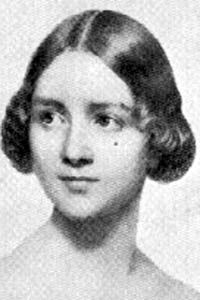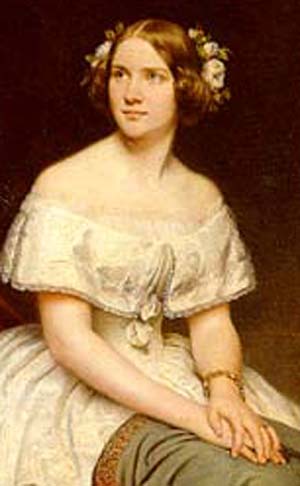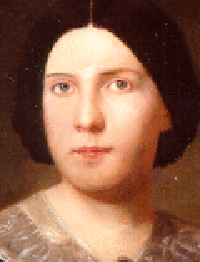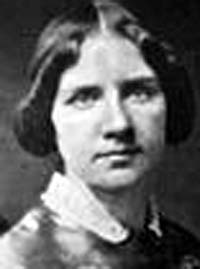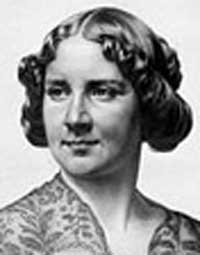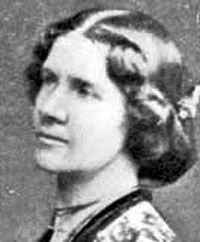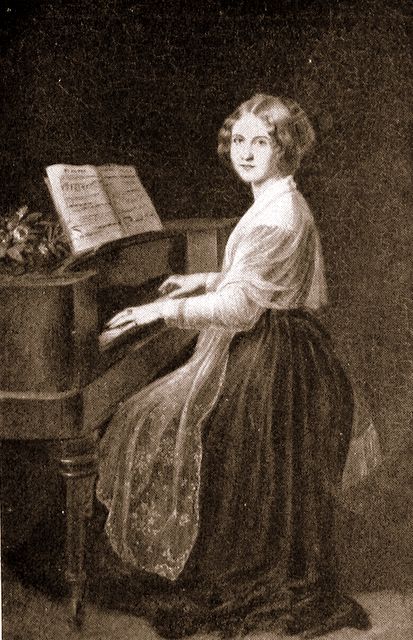Copyright Michael D. Robbins 2005
Astro-Rayological Interpretation & Charts
Quotes
Biography
Images and Physiognomic Interpretation
Jenny Lind
My voice is still the same, and this makes me beside myself with Joy!
Oh, mon Dieu, when I think what I might be able to do with it!
"The Grand Opening," middle section of a Nathaniel Currier lithograph (in 1857 became Currier and Ives) celebrating Jenny Lind's first US Appearance at New York's Castle Garden on September 11, 1850. She also performed her last US Concert at the Castle Garden on May 24, 1852. She sailed back to Europe on May 29, 1852
Parody of Jenny Lind's first American tour for impresario P. T. Barnum, New York City, September 1850.
Autograph of Jenny Lind in New York on September 13, 1850 two days after her first American concert.
Autograph of Jenny Lind after her February 5, 1852 marriage to Otto Goldschmidt.Johanna Maria Lind (October 6, 1820 – November 2, 1887), better known prior to February 5, 1852 as Jenny Lind, was a Swedish-born soprano singer, often known as the Swedish Nightingale. She signed her name as Jenny Lind.
After her Boston, Massachusetts February 5, 1852 marriage to Otto Goldschmidt (1829 - 1907) she was also known as Jenny Lind Goldschmidt and often signed her name as Jenny Lind-Goldschmidt.
Jenny was the illegitimate daughter of a schoolteacher named Anne Marie Felborg. After Jenny was born, Felborg married Nikla Lind.
Lind's October 6, 1820 recorded birthdate in Stockholm, Sweden is not conclusive as is noted in the following. Jenny arrived September 1, 1850 in New York City from Liverpool, England on the ship S. S. Atlantic where she listed her age as 39. This means that Jenny could have been born somewhere around October 6, 1810 and been a child resulting from her mother's earlier relationships. It is noted that Jenny's mother did give birth to a girl about 1810.
Jenny Lind was noted for her singing voice from a very young age. When she was about nine years old, her singing was overheard by the maid of Mademoiselle Lundberg, the principal dancer at the Royal Swedish Opera. The maid, astounded by Jenny's extraordinary voice, returned the next day with the ballet dancer, who arranged an audition and who helped her get accepted at the Royal Theater School.
Lind began to sing on stage when she was ten, and by the age of 17 she was a favorite in the Royal Swedish Opera. At age 20 she was a member of the Swedish Royal Academy and court singer to the King of Sweden.
Her first great role was Agathe, in Carl Maria von Weber's Der Freischütz in 1838. She was received throughout Europe with tremendous acclaim. She studied in 1841 with Manoel Garcia in Paris.
She traveled to London in 1847 where she became known as the Swedish Nightingale. Her first performance in England was on May 4, 1847, in the role of Alice in Giacomo Meyerbeer's Robert le Diable, which led to great successes in London, Manchester, Liverpool, Berlin, and Stockholm.
In January 1849, she performed in concert in Norwich England, the first concert was organised by the Norwich Choral Society. She liked the city so much that she gave two free concerts a month later. These concerts raised £1,253 for charitable purposes. The money raised was used to buy a house in Pottergate, which was converted into an infirmary for sick children.
Jenny rushed into an engagement with Captain George Jones of England but kept pushing back the wedding date while she negotiated with him over details of a marriage contract. Being a gentle but firm businesswoman as well as a singer, Jenny resisted his demand that she retire from the stage and sing only in church or for charity, and she also balked at a clause calling for her to turn over all her wealth to George. But it was George himself who doomed any marriage hopes when he fell asleep one night when Jenny was singing to him. Angry and hurt, she fled England for Germany hoping to forget George.
In the winter of 1849-1850 Jenny Lind became a member of the student fraternity Burschenschaft Hannovera in Goettingen, Germany. She was the only female member in a classical German fraternity. Her membership in the fraternity earned her the name Little Lady Jenny amongst the appreciative male members of the organization.
In 1849 P. T. Barnum became more familiar was Jenny's success and the large audiences she attracted. Earlier in 1845 and 1846 Barnum had toured Europe with his first great attraction, General Tom Thumb. Although he had never heard Lind sing, Barnum knew that concert halls sold out wherever she sang and that she was as well known for her virtues as she was for her voice. Barnum decided he wanted to bring her to the United States.
In October 1849, Barnum hired an Englishman, John Wilton, to locate Jenny Lind and make her an offer she could not refuse. After checking Barnum's credit rating with a London Bank, On January 9, 1850 Jenny accepted Barnum's offer of $1000 a night (plus expenses) for up to 150 concerts in the United States. Jenny also insisted on the services of Julius Benedict, a German conductor, composer and pianist with whom she had worked in England, and of Italian baritone Giovanni Belletti as assisting artist since solo recitals were still unknown to American audiences. Benedict's fee was $25,000 and Belletti's $12,500. All told, Barnum had committed to $187,500 (plus expenses) to bring Lind and her musical troupe to America.
Wilton returned to New York in February 1850. Barnum then learned from Wilton how good a businesswoman as well as an opera singer Lind was. She had required Wilton to include contract terms that the total fee for herself and the other two artists was to be deposited in advance with the London Banking House of Baring Brothers. Lind thought she had got the better of Barnum.
Barnum had not anticipated frontend payments for Lind since he always had paid performers in a more casual backend pay-as-you-perform manner. Barnum did not have enough liquid cash assets and had to raise money fast after various New York bankers refused to loan him the money based on a percentage of the Lind tour as collateral for the $187,500 that had to be sent to London. Barnum mortgaged all his commercial and residential properties and still came up short about $5000. Ever the promoter, Barnum finally persuaded a Philadelphia minister who thought that Jenny Lind would be a good influence on American morals to lend him the final $5000.
Few Americans had ever heard of Jenny Lind and Barnum needed to advertise and promote her. On his train trip way back from Philadelphia to New York, Barnum started boasting to the conductor that he just signed a contract with Jenny Lind and she was coming to America. "Jenny Lind!" replied the conductor. "Is she a dancer?"
Barnum's enlightening of the American press and potential audiences commenced as soon as he returned to New York. His first press release set the tone. "A visit from such a woman who regards her artistic powers as a gift from Heaven and who helps the afflicted and distressed will be a blessing to America." Barnum then authored a Jenny Lind biographical pamphlet and photograph that proclaimed: "It is her intrinsic worth of heart and delicacy of mind that produces Jenny's vocal potency." Barnum accurately determined that Jenny's piety and her record of giving frequent benefit concerts for hospitals and orphanages would weigh more heavily with the nonmusical public than the fact the singer had a range of two and a half octaves and an extraordinary heavenly voice.
As Jenny's arrival in America grew nearer, Barnum redoubled his efforts to drum up interest. In mid August 1850 before Jenny left England for America he had her give two farewell concerts in Liverpool. The first concert was on August 16, 1850. Barnum had ordered his British agent to go to London and "Procure the services of a musical critic". The critics were requested to go to Liverpool to cover the concert. The review detailed the overwhelming enthusiasm of the Liverpool audience and its grief at Lind's imminent departure. This review was not only widely circulated all over England and Europe but more importantly to Barnum it appeared in American newspapers a week before Jenny Lind arrived in America on September 1, 1850. This is the essence of Barnum's genius at promotion, public relations (PR), and publicity.
Lind left Liverpool on Wednesday morning, August 21, 1850. Some 10 days later on August 21, 1850 Lind sailed to the United States on the ship S. S. Atlantic and under the management of P.T. Barnum. Over 40,000 people greeted her arrival at the pier for the Collins Line ship captained by Mr West.
On the voyage to America, she gave her first concert to the ship's crew. A piano had been placed aboard at the insistance of Barnum. Jenny Lind was accompanied on the ship by Mr Wilton, Barnum's agent, Benedict, Belliti, Max Hjortzberg (Jenny's cousin), two servants and a valet. They stayed at the Irving House Hotel in New York City where 20,000 persons greeted Jenny's arrival.
She went on a concert tour of a number of American cities. In all she gave 93 concerts in partnership with Barnum. Lind netted over $250,000 from these concerts whereas Barnum made at least $500,000. Lind gave a vast majority of her US concert earnings to charities, including $1000 to help build a church in Chicago. Barnum and Lind renegotiated their contract on September 3, 1850 giving Lind the original $100 per concert agreed to plus the remainder of a concert's profits after Barnums $5500 concert management fee was paid. Lind was represented by her lawyer John Jay who put the new agreement in writing.
Her first American performance was given in New York City on Wednesday September 11, 1850 at the Castle Garden Theater, now known better as Castle Clinton. Barnum had devised a ticket auction for the first concert and his business neighbor, John N. Genin, the hatter, purchased the first ticket for $225. All together $10,141 was collected by Barnum for the first concert where some 3000 attended. Her second concert was given on Friday September 13, 1850 to a sellout audience with receipts over $14,200. These first two concerts were deemed "Charity Concerts" by Lind and Barnum. The "First Regular Concert" was given Tuesday September 17, 1850.
On Saturday September 14, 1850 at about 12:30 PM and at the direction of P. T. Barnum, Jenny Lind had her first American photo or daguerreotype taken by her Swedish friend, Poly Von Schneidau, from Chicago. It was taken at the Mathew Brady Studio in New York City near Barnum's American Museum.
Lind is reported as giving $5000 to her Swedish friend, Poly Von Schneidau, to purchase a new camera for his Chicago Studio. He did, and this daguerreotype camera snapped a portrait shot of Abraham Lincoln in Chicago on October 27, 1854. The Lind photo is in the Library of Congress Collection (Call Number DAG 509X). A 1858 ambrotype print of the 1854 daguerreotype was purchased in 2006 for $150,000 by the Springfield, Illinois Abraham Lincoln Presidential Library & Museum.
The American Lind tour was a great success, and it was then that she became known in the American press, as she had in England, as the "Swedish Nightingale". In Washington, DC during the 1850 tour she was the first performer in the newly renovated National Theater. The "New National Hall" was enlarged to seat 3,400 people for her arrival. The entire police force was called out to keep order in the crowd clamoring for tickets. Congress was adjourned and the Supreme Court Justices attended.
While in the United States, Jenny married on February 5, 1852 a young pianist, Otto Goldschmidt, at 20 Louisburg Square, Beacon Hill, Boston. Jenny and Otto returned to Europe together in May 1852 on the same ship she came to America on, the S. S. Atlantic.
Otto and Jenny had three children: Walter Otto Goldschmidt, born September 1853 in Germany, Jenny Maria Katherine Goldschmidt, born March 1857 in England and Ernest Svend David Goldschmidt, born January 1861 in England.
Although she ceased her professional singing career with her return to Europe, she continued to perform in a number of oratorios, concerts, and choruses, with a particular interest in Bach. She lived in England for the remainder of her life, where she became a philanthropist, and for some years a professor of singing at the Royal College of Music. Her last public performance was at Düsseldorf on January 20, 1870, where she sang in "Ruth", an oratorio composed by her husband.
She passed away on November 2, 1887 as a result of cancer. Jenny Lind lived her last years at Wynd's Point, behind the Little Malvern Priory, and is buried in the Great Malvern Cemetery in Malvern, Worcestershire. She bequeathed a considerable part of her wealth to help poor Protestant students in Sweden receive an education.
50 Kronor (about US$7.25)The artwork on the Swedish 50 krona banknote has a musical theme, the front of the note featuring a large portrait of Jenny Lind as a tribute to her memory.
Lind's fame garnered her many commemorations in Western societies. In Britain, when the Pottergate infirmary was closed in 1898, a new Jenny Lind Infirmary for Sick Children was built in Unthank Road, which opened in 1900. The Lind Infirmary itself closed in 1975, with the children's services transferred to Norfolk and Norwich Hospital, St Stephen's Road. Lind was again honored in 1985 when this Norfolk and Norwich wing was named the Jenny Lind Children's Department. When the new Norfolk and Norwich University Hospital was established in 2001, the Lind Department moved with it, where it remains to this day.
There is a plaque commemorating Lind in The Boltons, Kensington, London. Under the name "Jenny Lind-Goldschmidt", she is commemorated in Poet's Corner, Westminster Abbey.
Many objects have been named for Lind as well, including the Jenny Lind locomotive and the gold-rush town of Jenny Lind, California (despite the fact that she only performed on the East Coast while in the United States). During her visit to America, she was reported to have slept in a bed with turned spindles, leading to the naming of a bed or crib with vertical bars on all sides as a "Jenny Lind cot" (or crib or cradle).
Many artistic works have honored or featured Jenny Lind. Anton Wallerstein composed the "Jenny Lind's Lieblings-Polka" in 1845.[1] In the 1930 Hollywood film "A Lady's Morals," Grace Moore starred in the role of Jenny Lind and Wallace Beery appeared briefly as P.T. Barnum. [1] In 1941 Ilse Werner starred in the German-language film Schwedische Nachtigall as Jenny, with Joachim Gottschalk as Hans Christian Andersen. In January 2005, Elvis Costello announced that he was writing an opera about her, called The Secret Arias. It includes songs by Hans Christian Andersen, who like George Jones had fallen in love with Jenny.
Reportedly, Lind was extremely jealous of fellow Swedish soprano (and successor to the title "Swedish Nightingale") Christina Nilsson. In a bid to redirect attention being given to her rival, during an interview with a reporter after a performance by Sicilian-American Adelina Patti, Lind dismissed Nilsson with the emphatic opinion that Patti was a far better singer than Nilsson ever could be. Jenny Lind-Goldschmidt
LIND-GOLDSCHMIDT, Jenny, vocalist,
born in Stockholm, Sweden, 6 October, 1821; died in London, 2 November,
1887. She early manifested musical ability, and at the age of seventeen
appeared on the operatic stage in her native city. After a thorough training
with eminent masters she began her musical career, appearing with remarkable
success in the capitals of Europe. Paris remained the one exception. In
1849 Jenny Lind came to this country, under the management of Phineas
T. Barnum, for an extended concert tour in our large cities. Under this
arrangement 95 concerts were given, for which the receipts amounted to
$712,000, her share being $176,000. In 1851 she was married in Boston
to Otto Goldschmidt, a composer and pianist, and soon afterward went to
Europe, where she has appeared only occasionally in concerts and oratorios.
For many years she has lived in retirement in London, and is well known
for her private charities and Christian character. Her voice had power,
sweetness, flexibility, and the extreme range of high soprano, combined
with purity of intonation and musical sensibility. Her ornamentation was
remarkable for variety and originality, and she was unrivalled in the
management of very soft passages. The "Swedish Nightingale"
continued her intercourse to the last with many New World friends, and
to the writer said, "I shall never cease to love America and the
Americans, for there I spent some of my happiest days." She suffered
a stroke of paralysis 29 September, 1887, from which there was no hope
of her recovery.
